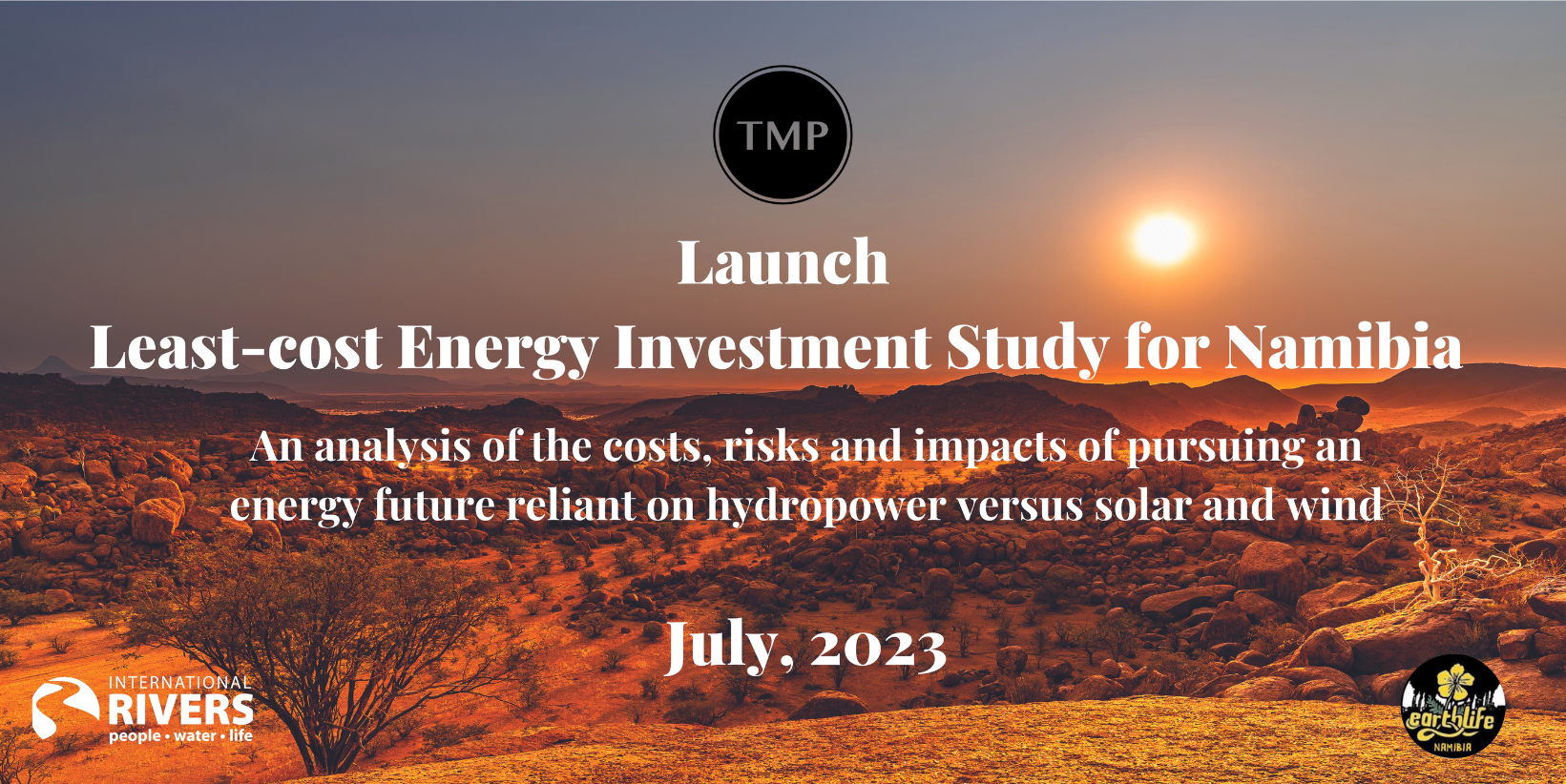TMP Public electricity sector assessment demonstrates that solar and wind represent the least-cost pathway to meeting Namibia’s current and future energy demand
FOR IMMEDIATE RELEASE July 18, 2023
Media contacts: Aqeelah Hassen, Communications and Campaigns Coordinator, International Rivers, ahassen@internationalrivers.org
Windhoek, Namibia – Today, International Rivers and EarthLife Namibia released a study by TMP Public on the least-cost pathway for Namibia’s energy needs. Namibia is at a crucial point in its energy system development and must make difficult decisions over the coming years to increase energy supply as demand could double in the next 20 years, while also managing costs and negative impacts.
Namibia currently has a small energy system that is dominated by its 347 megawatts (MW) Ruacana hydropower plant. The country is also considering an additional hydropower plant, the Baynes Hydropower Project on the Kunene River. The Kunene River basin is heavily climate-exposed and extreme drought periods have already created energy shortfalls for Namibia because of its over-reliance on the Ruacana hydropower plant. Namibia is one of the driest countries south of the Sahara and has been experiencing persistent drought conditions for more than seven years. These events are likely to become more frequent and severe over the coming decades, exacerbated further by competing upstream water demands.
Bertchen Kohrs, chairperson of Earth Life Namibia points out that, “Earthlife Namibia critically observed the planned hydropower plant at Epupa in the 1990s. A similar plant in the Baynes Mountains raises the same environmental and social concerns. Namibia is blessed with renewable energy resources like solar and wind. It would be a shame not to utilise them.”
These growing climate risks create strong incentives for energy planners to favour solar and wind and to balance an energy system already overburdened by increasingly unreliable hydropower. Solar and wind technologies are far more climate-resilient and can be dispersed in a way that considerably reduces the chances of a single climate event disrupting the entire energy system.
“Namibia should reconsider its reliance on hydropower and fossil fuels in favour of a climate-friendly and innovative approach that makes use of its abundant renewable resources and avoids negatively impacting communities,” says Siziwe Mota, Africa Program Director at International Rivers.
The Least-cost Energy Study commissioned by International Rivers and EarthLife Namibia, and conducted by TMP Public, provides a least-cost energy investment pathway for Namibia until 2040, alongside a comparative analysis of the proposed Baynes Hydropower Project and least-cost solar and wind alternatives. The analysis covers both techno-economic factors, providing multiple assessments that consider costs, social and environmental impacts and risks, as well as forward-looking climate factors for different energy technologies.
Some of the report’s key findings include:
- Solar and wind with storage make up the largest share of Namibia’s energy future under a least-cost energy investment scenario to 2030 and 2040, cumulatively accounting for 70% and 77% of the country’s installed capacity, respectively.
- Namibia has widespread high-quality solar and wind resources in areas that avoid dense populations, protected areas, and sensitive land uses. Nearly 125,000 km2 of the most suitable solar and wind areas also pose a relatively low social risk.
- The Baynes Hydropower Project is heavily susceptible to delays because of high social and environmental risks and is unlikely to come online before 2031. By contrast solar and wind options could be developed in less than half the time.
- Electricity from Baynes would cost at least 66-166% more than existing domestic wind and solar alternatives by 2031. These high costs would likely drive up the price of electricity for Namibia’s energy consumers.
- Drought events are likely to become more frequent and severe by 2030, with knock-on effects for Namibia and the region, which uses hydropower extensively to generate energy for export. Solar and wind offer resilience to these climate impacts.
- The domestic job creation potential of solar and wind is more certain than it is from Baynes.
- The Epupa site was found to have greater negative impacts, but Baynes would still flood indigenous dwellings, critical grazing land and culturally significant sites.
“Namibia urgently needs to improve the resilience and capacity of its energy system, both because of looming climate risks and to improve livelihoods and opportunities in the country. Fortunately, it is endowed with excellent renewable energy resources, like solar and wind. It is imperative that decision-makers support energy solutions that offer resilience and rapid rollout, which means rethinking some of the large, risky, and ultimately expensive options currently on the table,” says Justin Muhl, associate at TMP Public.
Access to the full report and policy brief
For more information visit www.internationalrivers.org

